This article was originally published by Brandon Smith at Alt-Market.

It’s an interesting dynamic that the Federal Reserve has conjured in the decade after the 2008 credit crash. They spent several years using artificial stimulus measures to inflate perhaps the largest financial bubble in the history of the US, and then a couple of years ago something changed.
They addicted markets and investors to easy cash only to then cut off the flow of monetary heroin. The system was so dependent on the Fed’s “China White” that all it took to give everyone the shakes was interest rate hikes to the neutral rate of inflation and a moderate balance sheet selloff. Now, the system is dying from shock and it’s too late for intravenous stimulus to save it.
For many, this might seem unprecedented, but it’s really rather common. The Fed has a long history of inflating bubbles using easy liquidity and then imploding those bubbles with the tightening of credit. It also has a long history of pretending like it is trying to save the economy from a crisis when it is actually the source of the crisis. As Congressman Charles Lindbergh Sr. warned after the panic of 1920:
“Under the Federal Reserve Act, panics are scientifically created; the present panic is the first scientifically created one, worked out as we figure a mathematical problem…”
In the latest theatrics of the Fed, a new trend has emerged – The “disappointing Fed”. In order to understand this disappointment, we have to define exactly what markets want from the central bank. Obviously, they want QE4; a massive liquidity program. For the past year at least they have been clamoring for it, and they still have yet to get it. But what does QE4 entail? In order to institute a new QE marathon the Fed would have to:
1) Lower the Fed funds rate to zero.
2) Lower the overnight repo lending rate to zero.
3) Stop balance sheet cuts.
4) Launch permanent asset purchases, NOT just overnight lending backed by collateral.
If the Fed was planning to kick the can on the collapse of the Everything Bubble, they would have initiated all of these steps and they would have done it at least 6-8 months ago. So far, only one of these things has been done (the end of balance sheet cuts). Here we see why the mainstream economic world is continually on the verge of a conniption fit. The implosion of the financial bubble is becoming obvious, most major corporate institutions and banks are stretched thin by historic levels of debt and dollar liquidity has become so tight globally that interbank lending rates are skyrocketing well above the Fed’s set interest rates. Yet, after every Fed meeting, the central bank gives the investment world a bare-bones response.
Here is the question people should be asking but almost no one is: Why? Why didn’t the Fed just open the floodgates on QE4 back in November/December when it was obvious that a liquidity crunch was forming? Why did the Fed hike interest rates and cut their balance sheet at all? The only thing it achieved was to spark crash conditions.
Ah, but there is the key to answering our conundrum…
Since around November of last year, the Fed has entered into a rather consistent pattern in which it does the bare minimum to make it appear as though it plans to support markets and defuse any crisis event while actually not doing much of anything. There comes a point where “kicking the can” on economic collapse becomes impossible, and I believe we have now reached that point according to the evidence. As I’ve noted in past articles, the Fed would not loosen the noose on liquidity until the crash starts to hit the consciousness of the general public. In other words, the Fed will not unleash QE4 until we are on the verge of another “Lehman Moment”. That time has nearly come.
Today, almost half of all Americans are worried about a recession striking in the next year, and 38% of fund managers expect a recession in the next year. The public is growing increasingly aware of the threat, but many still believe the Fed and government will act to mitigate the damage.
The liquidity crisis forming in overnight loans and the accelerating “repo panic” is a sign that crash conditions are about to hit Mainstreet. Repo lending is a Fed mechanism for increasing the flow of credit within the banking system (hypothetically). Repo interest rates are the interest rates banks and other institutions charge each other for borrowing cash. Usually, repo interest rates follow the overnight lending rates set by the Fed, as well as the Fed Funds rate. But, recently, interbank rates have spiked far beyond the level the Fed has set.
Why is this important? Because it means that there is a supply/demand shortfall. Multiple banks and corporations need to borrow money on a short term basis to keep their operations functioning. This makes sense; US companies are currently weighed down by more debt than they were before the crash of 2008. The problem is, no one wants to lend that cash to them right now. There is, essentially, a dollar and credit shortage, and the demand is causing rates to skyrocket. The higher the rates, the more expensive it is for EVERYONE to borrow, including small businesses.
Confusion has erupted as to why banks and companies with large cash reserves won’t lend that money out, even at the high-interest rates of the panic spike. Warren Buffet’s company, Berkshire Hathaway, for example, is holding a record $122 billion in cash. What do Berkshire and other cash-heavy companies know that we do not? Generally, companies hoard cash when they are expecting an economic crisis, and, in a way, this cash hoarding can actually contribute to an exponential credit collapse. This is what happens when the lifeblood of your economy is based on debt on-demand.
Without anyone willing to lend at current interbank rates, the lender of last resort is the Fed, but the Fed’s response has been decidedly underwhelming for most investors.
Some see the Fed purchases for repo overnight lending as a sign that the Fed will soon step in with QE. Some people even believe that the repo spending is QE. Unfortunately, as with much of what the Fed does, not everything is what it seems and the repo situation is complex enough that I don’t think many people understand it. As one of my readers recently asked:
“The New York Fed said on Friday it would continue to offer to add at least $75 billion daily to the financial system through Oct. 10, prolonging its efforts to relieve pressure in money markets…Counting from today that’s 20 X 75B = 1.5 Trillion. Is this a form of QE? And would it avert the impending crash…?”
This is a common misconception about Fed overnight loans and repos. To put it in the simplest terms I am able – Repos are not generally cumulative long term purchases like QE is. Repos are usually OVERNIGHT LOANS that institutions like banks borrow from the Fed while offering collateral in return (secure financial assets).
Repos create TEMPORARY reserve balances, which are paid back and erased. Meaning, the Fed may offer Repos until October 10th, but this will not add $1.5 trillion to the Fed’s balance sheet. On the contrary, the Fed’s balance sheet will move relatively little as the Fed sells back the collateral it purchased, often with a haircut attached that feeds extra capital into the central bank.
Answer: No, repos are not QE. QE is not temporary, nor is it based on collateral purchases that are sold back daily. Also, as almost every economist, even in the mainstream, has been pointing out, the Fed would have to institute REAL QE and FAR MORE liquidity to relieve tight financial conditions, yet, they are not doing this. They are calling the Fed repo action a “bandaid”, and I tend to agree. The Fed is keeping conditions tight for as long as possible. Again, what people need to start asking is “why”?
From Reuters:
“What’s more, an IOER cut is simply a temporary bandaid for the solution and the Fed will need to come up with a more permanent solution going forward. Expanding the Fed balance sheet features in the menu of possible solutions, and Powell made a strong effort to communicate clearly that it should not be interpreted as quantitative easing, aka policy stimulus, rather than a technical tool to increase currency in circulation.”
As another of my readers argued this week:
“I’m so tired of seeing people in the alt-media community call the repo lending “QE” when it absolutely is not QE. All they have to do is a little research to understand that the fed has been dodging QE and they’ve been keeping conditions tight. Like you’ve been saying for a while now, the bankers created the bubble, now they’re bursting the bubble by restricting liquidity. Maybe they’ll have QE4 in the future, but only when it’s too late to do anything about the liquidity crisis…”
That just about sums up the problem and the misconceptions bouncing around lately. The Fed has been well aware of the brewing liquidity crisis for quite some time. The US dollar LIBOR rate witnessed the biggest jump in a decade in early 2018, and the global dollar shortage has been consistent since then. With a dollar shortage comes greater demand by banks around the world for high-cost short term debt – hence, repo rates skyrocket.
For several years the Fed was not shy at all about pumping vast amounts of fiat into the banking system; why are they shy about it now? And why aren’t we in the middle of QE4 yet?
A startling factor in short term interbank lending is that as repo rates inflate they can actually cancel out the effects of Fed stimulus measures. The Fed would have to dramatically increase its level of purchases to outpace the explosion in rates. They have not done this, and this is why their repo response has done little to stop interbank lending volatility.
To put the Fed repo response in perspective for those that want to treat overnight loans as cumulative, the audit of the TARP program alone shows the Fed injected around $16 trillion into the global economy, and much of that was in overnight loans. This is not even counting Fed QE programs post-TARP. The current Fed repo activity is a drop in the ocean by comparison.
I assert that the Fed is deliberately maintaining the liquidity crisis while trying to make it look like they are “taking action”. The Fed creates bubbles and then pops those bubbles by tightening liquidity into economic weakness. When they do ease credit conditions, it is almost always well after the avalanche has already started.
They did the same thing at the onset of the Great Depression, causing the crash to expand rather than retreat, as Ben Bernanke publicly admitted in 2002. They also kept crash conditions in credit markets hidden when Alan Greenspan shut down all conversation with the public on the housing bubble. And, today the Fed continues to fraudulently claim the US economy is strong and in recovery, and has even fired Simon Potter, the official most equipped to handle a repo lending crisis – the same official that warned the Fed response is basically too little too late.
The Fed can’t even claim that it “had no idea” what was about to happen. Jerome Powell, now Fed chairman, warned of these EXACT consequences if the Fed tightened liquidity back in 2012. But, of course, very few people in the public are aware of this, and whoever the Fed and the media blame for the crash will be who the majority of the public blames for the crash.
I don’t think it’s a coincidence that the crash of the Everything Bubble is accelerating around the same time that geopolitical chaos is erupting. We have a trade war that is unlikely to end, with a US/China meeting in October that will probably produce little to no results. We have a Brexit circus which is supposed to play out in October. We have a crisis with Iran as the US is set to move troops into Saudi Arabia and the UAE in the next month. And now we have an “impeachment inquiry” circus erupting over Trump, Biden, and Ukraine. That sure is a lot of distractions for the general public as their economy crumbles around them…
To understand why the Fed would deliberately engineer an economic crisis, I suggest reading my article on the economic end game HERE. It is important to realize that the Fed has not “lost control” of the situation, nor is the Fed the bumbling and witless institution some alternative analysts make it out to be. Rather, the Fed is perfectly aware of the damage it is causing, and it is perfectly aware of how much this chaos will benefit certain globalist organizations.










0 Comments